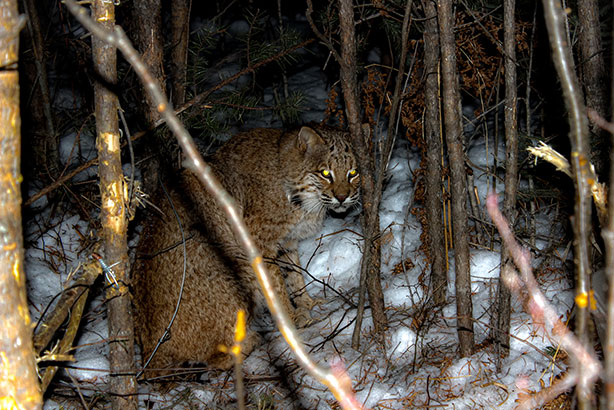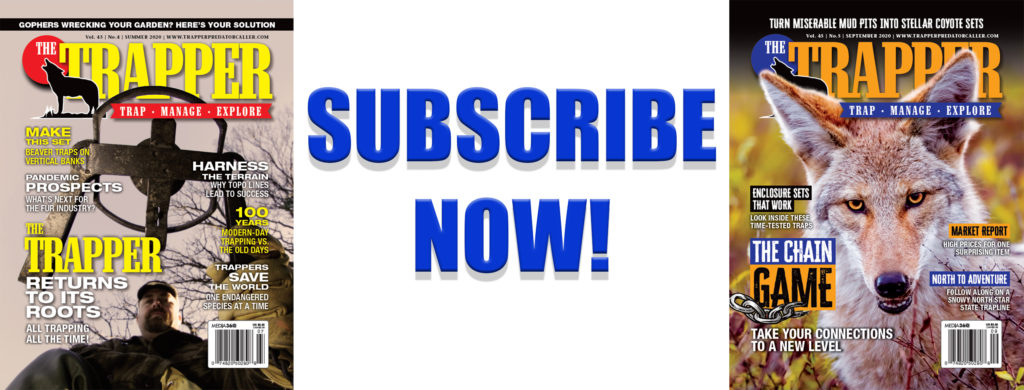Deep snow, howling winds and brutal temps won’t stop these hard-core steel-setters.
Text and photos by Jason Houser
As you read in the September 2020 issue of The Trapper, we were trapping marten and fisher in northern Minnesota with Adam Kane and his family. After that wonderful experience, we continued our adventure and pursued bobcats.
Growing up and trapping mostly in Illinois, bobcat trapping is not something we get to do a lot of. It was not that long ago that Illinois finally opened a long-overdue bobcat season. But, with only 500 permits issued per year, they are hard to come by and I have yet to get my hands on one.
That is not to say that I have not caught bobcats. I have caught plenty in Illinois that had to be released, and I have had the pleasure of trapping bobcats in South Carolina and Missouri. But, none of those experiences were anything like what we embarked on in northern Minnesota.
As you know from my last article, Adam Kane knows his stuff when it comes to trapping — from gray foxes to martens, weasels, bobcats — and everything in between.
The biggest obstacle that I learned about with Minnesota trapping is the weather. By the time that bobcat season opens in mid-December, deep snow and brutally low temperatures are the norm. If you’re waiting for nice weather to make sets this far north, you will not be making sets.
Howling winds, thigh-high snow and temperatures hovering around zero degrees will make the average trapper cringe with the thought of running a line. To run a successful line in these conditions you have to have a love for the sport, determination and some guts. The Kane family has all of that in spades.
The saving grace for many trappers in northern Minnesota is the ability to trap large tracts of public lands. Being able to trap these areas allows trappers the option of making sets close enough to the road that they can be checked with a good pair of binoculars.
If you think theft would be a problem, it is not. Adam can conceal his sets so well that unless you knew there was a set there, you would never see it. The only dead giveaway would be fresh human tracks leading to and from the set. That is why many trappers rely on optics to check their sets. The only time that tracks would be left behind is when the set is first made and when a catch is made. But, oftentimes, fresh snow and strong winds cover those tracks overnight.
The ability to read sign and to set on location is what makes the difference between an average trapper and a good trapper. I was highly impressed at how easily Adam was able to pick out fresh bobcat tracks in the snow, distinguishing them from other animals, as we drove down the snow-covered roads. After spotting a fresh set of tracks, we’d get out and Adam would quickly interpret the sign for up-to-date intel.
Kane made quick work of figuring out where the cat was coming from, where it was going, and what set would be best.
He prefers two sets to routinely catch bobcats. The first is a cubby set usually baited with muskrat carcasses, and the second is a blind set on trails. Footholds are another option, depending on the weather. If there is going to be a lot of snowfall, these traps do not perform very well.
The area we were trapping is home to some Canadian Lynx, so we had to be careful with the sets we made to avoid catching one. The lynx was once hunted and trapped in Minnesota, but due to declining numbers in Canada, the lynx has been protected in Minnesota since 1984. In 2000, the U.S. Fish and Wildlife Service classed the lynx as a federally threatened species.
Trappers have to be careful because the same sets made for bobcats are also attractive to lynx. The same lures and baits that attract bobcats also attract lynx. Adam was careful not to use visible baits of rabbits and hares that Lynx prefer. Instead, muskrats were Adam’s choice of bait.
When making the cubbies, it is crucial to make the openings in a manner to prevent an incidental catch of a lynx. The same with snares. There are restrictions on the size of the cable used, as well as the diameter of the loop.
To use muskrat as bait it had to be unfrozen and exposed to air for at least 24 hours before using. This proved to be more difficult than I imagined in the brutal temperatures we were working in. But where there is a will, there is a way. Also, we were careful using flags such as bird wings, feathers, pieces of fur and CDs. Flagging must be at least 20 feet from any trap or snare.
It was very frustrating as we checked the sets to find bobcat tracks on top of the cubbies or to see them walk around the snare in the trail. Another problem we faced was the flying squirrels and weasels. These little animals often set off the conibears within the cubby sets as they attempted to steal the bait.
The highlight of the trip was watching the excitement of the kids as they came upon a trapped bobcat. Bobcat after bobcat that we caught was just as exciting for the kids, and adults, as the first one.
Not only was it the Kanes that were catching bobcats, but Adam makes it a point to pass on his knowledge and love of trapping to anyone who needs it. Fortunately, I was able to experience this firsthand in just the few days that I spent with him.
One particular young trapper comes to mind. We had the pleasure to tag along with a young trapper, Jax Guddeck, and his father Drew. Drew has been trapping for a few years, but had not had much experience with bobcats.
With advice from Adam, Drew and Jax made a natural cubby set not far from their home in an area a big bobcat was known to frequent.
A couple of days passed without any activity and Adam got the exciting call from Drew saying they had connected on a bobcat. Jax was not with his father when he checked the traps and had no idea they had caught one. It was not the big one that was frequenting the area, but the father/son team successfully trapped a bobcat. Adam stopped what he was doing and made the short drive to be there when Jax saw his first bobcat.
The excitement from Adam for those two is what trapping is all about. It is helping other trappers succeed and celebrating their accomplishments with them.
When we arrived at Drew’s home, Jax was just strapping into his snowshoes to make the trek to the set, still not aware a bobcat was waiting.
Being there to see the excitement on his face when the young trapper rounded the bend and saw the bobcat is permanently etched in my mind.

A late-night snowmobile ride to check traps was an exciting new thrill for the author. Photo credit Jason Houser.
Some other memorable adventures were with Tony Crow, when we made a nighttime ride on snowmobiles deep into the Minnesota forest as Tony wanted to share his big tom with us. And when Ben Wolney caught a couple of nice bobcats a couple of days apart. Each call from Ben showed more excitement than the one before. And the excitement held as we relived the catches through his storytelling. Those are all things that will stick with me for as long as I am walking this earth.
The opportunity to spend this time with the Kane family and their friends is something that I will never forget. That is what trapping is all about for me. Passing on our knowledge and passion to other trappers. For trapping to continue as we know it, we must get more trappers involved. And, it all begins with sharing information just like Adam did with me and others.








